The interesting story of Koi, a spectacular carp made of light and wood of over 3 meters by LZF
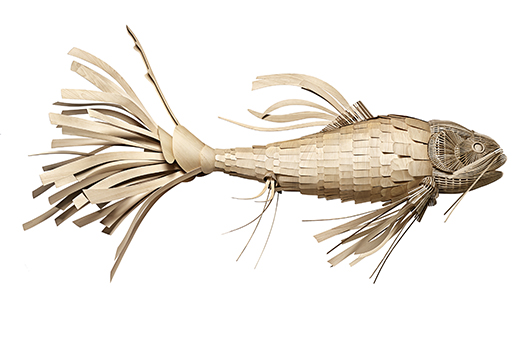
Koi is a huge carp made of light and wood, a spectacular light structure, half-lamp, half-sculpture. This awesome piece by Spanish company Lzf Lamps, presented at the Euroluce 2015 show in Milan, has a long and interesting history behind...
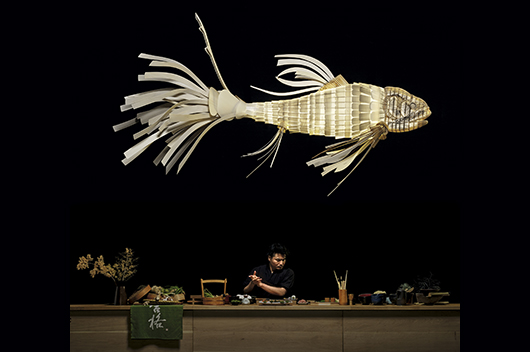 title="Más..." />
title="Más..." />
Koi, based on the charecter created by Inocuo The Sign is the longest running project at LZF LAB, beginning in 2009 with the Armadillo lamp. The inspiration for this wonderful idea came from an interlacing wood system and the transparencies it produces when it is lit. The system, consisting in the overlaying of wooden slats, as if they were scales, is called the “Koi Fabric”, used for making iluminated walls.
In 2010 this fabric turned into the skin of a disturbing animal, a wooden carp which fed on light in a Motion Graphics film production. We had the fabric, transformed into scales, the carp which fed on light, and also a lot of material from the LZF LAB. Finally, in 2013, we could no longer resist and set out to actually build it. A long process which would not have been possible without the collaboration of the artist of this piece, Inocuo The Sign, the creator of the “Koi” movie.
The result is a stunning handcrafted piece measuring more than three metres from head to tail. Koi consists of a wooden frame, constructed using traditional techniques, which supports the skin, made of dozens of small wood veneer pieces.
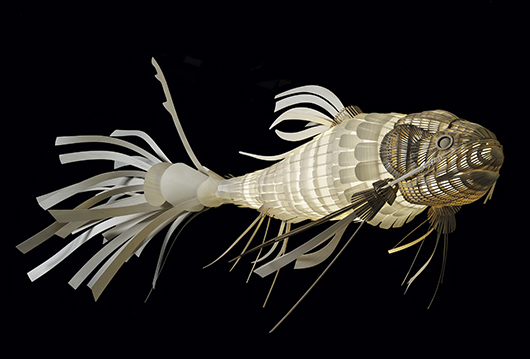

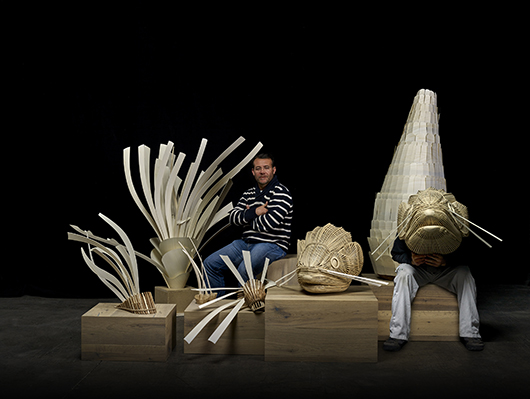
KOI. THE ORIGIN
Although Koi is now a carp, its original inspiration came from another animal, the armadillo, which the designer Luis Eslava used as the basis for the design of a new lamp for LZF in 2009. Armadillo was formed by overlapping wooden rectangles resembling the shell of the animal.
“...Luis’ prototype caught our attention immediately and we sought to maintain the same energy provided by the small overlapping parts when the lamp was lit, both on the inside and the outside. For a whole year, this was the work programme: the play of transparencies obtained by partial asymmetric overlaps. The result was a beautiful, powerful piece, both lit and unlit”.
Then again, thanks to the way LZF LAB operates, our quest had developed this into an innovative wooden fabric, the “Koi Fabric”, a sea of golden highlights which would soon offer new perspectives.
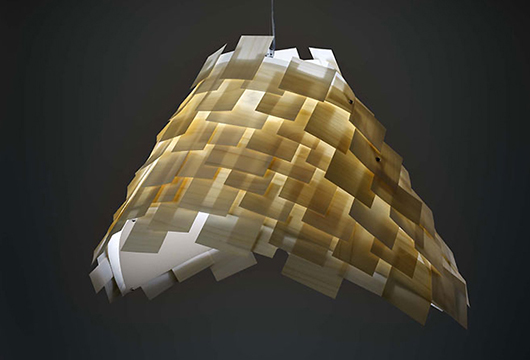
KOI FABRIC
Armadillo immediately caught Mariví and Sandro's attention, and they had the certainty that a new range of possibilities opened up. They knew it was worthwhile to invest the necessary resources into a project that could spark something new.
This is how a comprehensive study on a new way of playing with light using the overlapping and transparencies of wood veneer began at LZF. The result of this process was twofold; the Armadillo lamp and what we call the “Koi Fabric”, which takes its name from its resemblance to fish scales.
For the public presentation of Armadillo, LZF held a spectacular performance in Valencia. Large curved panels of “Koi Fabric” built with over 4,000 pieces of backlit veneer surrounded the audience, creating a surreal atmosphere. The semi-mirrored floor doubled the space, and almost without realising it, people ended up standing in front of the only piece which was hung inside, the Armadillo.

Later, for the presentation in New York, Emilio Lekuona incorporated Inocuo The Sign into the team and presented the “Koi” film in Milan.
The “Koi Fabric” kept bearing fruit and popped back into the imagination of the creative team at LZF, now accompanied by the magic of Inocuo The Sign.
KOI THE FILM
A Motion Graphics Experiment
Back in 2011, Inocuo was involved in a live mural for LZF to present “The Butterfly”, an event organised for the presentation of the Agatha lamp in New York. The collaboration was so positive that we immediately decided to continue working together on another adventure we were all passionate about: “Koi”.
The new project was born in New York: a Motion Graphics film, an audiovisual work starring a three-dimensional CGI “Koi” inspired by the translucent scale fabric with which we were working with such passion. After dozens of sketches, “Koi” took a recognisable shape.
“Koi” the film was presented at the Euroluce fair in Milan in 2011. The film begins with balls of light falling into a deep pool. Koi appears in the middle of the darkness, a wooden carp which feeds on light and becomes a light sculpture with a life of its own. Our idea had taken shape; “Koi” had become a powerful animation
Since we fell in love with the character created by Inocuo The Sign, the next phase was inevitable: we had to recreate it into a tangible, real, bright, light Koi. A huge technical challenge was awaiting. We had to build a skeleton which could be lit and would convey a feeling of lightness.
KOI. THE ARTISAN
LZF Meets Tradition
This is 2013. We are looking for possible solutions to move forward with the Koi. Fortunately, we did not have to go very far. Mac Diego, a Valencian designer and comic publisher, put us in touch with Manolo Martin, a famous local craftsman who knows how to create volumes with strips of wood.
To solve the structural problem of Koi, Manolo Martin used the “vareta”, a traditional technique which has practically disappeared today. The “varetas” are thin strips of wood which can be bent to create all sorts of shapes.
Thanks to Manolo Martin's delicate work, “Koi” finally had a skeleton. The quality of the craftsmanship is especially noticeable in the details of the head, tail and fins. The skeleton was covered with the “Koi Fabric”, placing dozens of small pieces of natural wood veneer to recreate the scales of a carp. Inside, we chose LED technology as the source of light. In addition, the Koi has two independent control systems to regulate the light intensity through Bluetooth devices.
Finally, in 2015, after more than five years of work, our Koi finally shines with its own light.

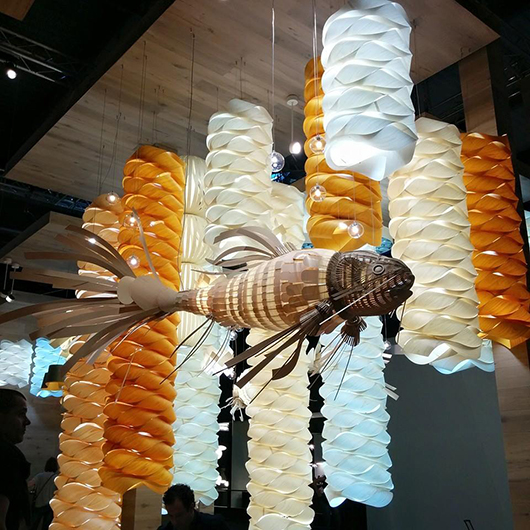
Euroluce 2015 - Milan
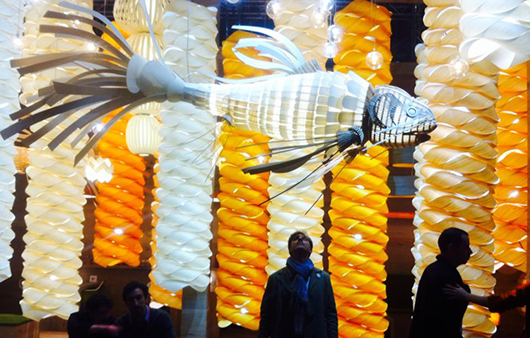 Euroluce 2015 - Milan
Euroluce 2015 - Milan 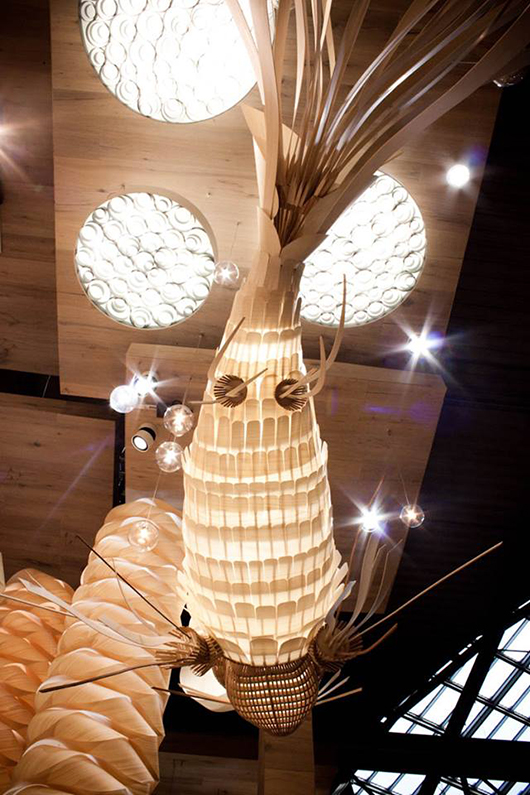 Euroluce 2015 - Milan
Euroluce 2015 - Milan This long journey, the development process with the superposition of many different contributions, has been made possible thanks to the work of artists, craftspeople and technicians who joined forces to create something new and different for such a risky, ambitious and exciting project, which demanded nothing but the best from the LZF laboratory.
Source: LZF Lamps
Read more news related Lzf Lamps published at Infurma
Visit the Lzf Lamps website
News Infurma:
Online Magazine of the International Habitat Portal. Design, Contract, Interior Design, Furniture, Lighting and Decoration
